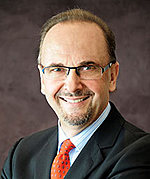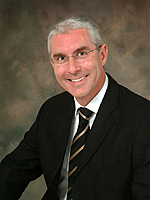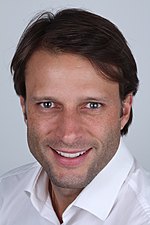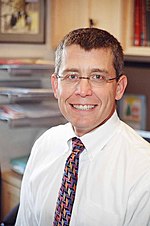Plenary Programme - Thursday 14 May
Implant supported fixed dental prostheses in partially edentulous patients have become a standard of care in dental medicine in the past 25 years. Today, these treatment protocols are well documented with numerous long-term studies and 10-year success and survival rates well above 95%. In the past 10 years, major efforts have been made to make implant therapy more attractive to patients by (a) reducing the number of surgical procedures, (b) reducing the pain and discomfort for patients, and (c) reducing healing periods and overall treatment periods. This progress was based on a better understanding of tissue biology, the development of further improved microrough, hydrophilic implant surfaces, and the development of much better 3D radiology with Cone Beam CT’s.
The lecture will review this progress from a surgical point of view including the discussion on post-extraction implant placement with immediate, early or late implant placement, the indications of flapless implant placement, and the utilisation of early implant loading in various clinical situations.
The lecture will be documented with case reports, and will present pre-clinical and clinical studies supporting the utilised surgical protocols.

Dr Daniel Buser has been Professor and Chairman at the Department of Oral Surgery at the University of Bern in Switzerland since 2000. He spent sabbaticals at Harvard University in Boston, at Baylor College of Dentistry in Dallas, and at the University of Melbourne.
He served as President of various academic associations including the European Association for Osseointegration (EAO) in 1996/97, the Swiss Society of Oral Implantology (SSOI) in 1999-2002, the Swiss Society of Oral Surgery and Stomatology (SSOS) in 2002-07. Most recently, he was President of the ITI (2009-13), the world’s largest association in the field of implant dentistry.
He received several scientific awards from professional organisations such as the ITI, the AO, the AAP and the AAOMS. Recently, he was honored with an Honorary Professorship by the University of Buenos Aires (2011), and the Brånemark Osseointegration Award by the Osseointegration Foundation in the USA (2013).
His main research areas are tissue regeneration around dental implants, surface technology and guided bone regeneration. He has authored and co-authored more than 300 publications and several text books including two GBR books and two ITI Treatment Guides. The research is well cited resulting in an h-index of 65. He widely lectures at national and international conferences.
Qualifications: DMD, Dr. med. dent
The paranasal sinuses constitute a functionally and anatomically complex system of interlinked cavities within the facial skeleton and anterior skull base. The intricate anatomy and physiology of this region means that the sinuses have important relationships with adjacent “neighbouring” structures. Sinus disease will often present with signs and symptoms in the nasal and sinus domain but equally often the presentation will be with symptoms affecting a neighbouring structure, e.g. the upper dentition, the eye and orbit or the intracranial compartment.
The proximity of upper alveolar structures to the maxillary sinus underlines the requirement for practitioners who perform implants and other maxillary procedures to appreciate the pathophysiology of the sinuses.
In this presentation I discuss current theories of sinus anatomy, physiology and pathology and illustrate the interconnected nature of the nasal and paranasal sinus systems. Key developments in endoscopic sinus surgery (ESS) and the role of technology in diagnosing and treating sinus pathology will be explored using clinical case scenarios and operative videos.
Appreciation of the form and function of the paranasal sinuses in health and in disease is invaluable to dental practitioners.
Understanding the sinuses means that when faced with unusual symptoms, complications of implant surgery or unexplained alveolar pain the dental surgeon will be more able to answer the question…”could there be trouble with the neighbours?”

Gerry has been a Consultant Head and Neck Surgeon in Glasgow Royal Infirmary since 1995. His main interest is the application of endoscopic and minimally invasive surgical techniques for treating nasal, paranasal and anterior skull base tumours. Academic activities include numerous publications on extended applications of endoscopic sinus surgery, endoscopic vascular ligations and other aspects of Head and Neck Surgery. Gerry has contributed to many international textbooks in both author and editorial roles and runs an advanced endoscopic surgical training course in the Royal College of Surgeons of Edinburgh. In addition to participating on the faculty of many national and international surgical training courses, Gerry is regularly invited to lecture to other specialties. When not at work he spends his time seeking adventure in the mountains.
Qualifications: MB ChB MD FRCSEd FRCS (ORLHNS)
Treatment planning a full mouth rehabilitation is amazingly challenging. So many options and steps must be coordinated and controlled to achieve a successful outcome. Developing the Smile Design is just the starting point. Carefully integrating this design to function is the key. This presentation will show how this process is a complex brainstorm that needs to be guided by logical and rational steps to achieve consistent and predictable solutions.

Dr Christian Coachman graduated in Dental Technology in 1995 and in Dentistry at the University of São Paulo-USP/Brazil in 2002. He started his work with his father, Dr Robert Gray Coachman in the Keys-Coachman Institute in São Paulo, Brazil that now is the Well Clinic Dentistry www.wellclinic.com.br. Moreover, Dr Coachman attended the Ceramic Specialization Program at the Ceramoart Training Centre in Brazil, where he also became an instructor.
In 2004, Dr Coachman was invited by Dr Goldstein, Dr Garber, and Dr Salama, of Team Atlanta, to become Head Ceramist of their laboratory, a position he held for over 4 years. He is a member of the Brazilian Academy of Dentistry and the Brazilian Society of Esthetic Dentistry; and of the American Academy of Esthetic Dentistry (AAED).
Dr Coachman has been working with many leading dentists around the world such as Dr Eric Van Dooren (Belgium), Galip Gurel (Turkey), Mauro Fradeani (Italy), Michael Cohen (Seattle Study Club, USA), Nitzan Bichacho (Israel), Nikolay Bakhurinskyi (Moscow, Russia), Giano and Andrea Ricci (Italy), David Dunn (Sydney, Australia), Rajiv Verma (India), Tal Morr (Miami-EUA), in Brazil with Sidney Kina, Claudio Pinho, Paulo Kano, Mario Groisman, Marcelo Calamita and in the Well Clinic SP.
Currently he is the scientific coordinator of the e-learning website www.identalclub.com and www.digitalsmiledesign.com and works as a consultant for Dental companies and offices developing products and implementing concepts and has lectured and published internationally in the fields of aesthetic dentistry, dental photography, oral rehabilitation, dental ceramics and implants.
Qualifications: CDT DDS
Intra-oral scanning (IOS) can increase efficiency by decreasing chair and lab time for many labour-intensive procedures. IOS procedures offer a new philosophy for restoring single or multiple teeth, fabricating surgical templates, implant abutments and frameworks. By making intraoral digital impressions, or digital scans of models, or impressions, CAD/CAM restorations can be designed, outsourced or milled in the office. The use of IOS technology and the detail of chair-side and laboratory communication, implementation and the complete digital solution will be presented. Using IOS and CBCT together has many advantages, and these will also discussed. Dr Jansen will review the expanding options for the surgical restorative dental team using IOS.

Dr Jansen graduated from the University of Southern California (USC) School of Dentistry in 1986 where he also received his certificate in Advanced Education in Prosthodontics in 1988. In 1989, he accepted a full time teaching position at USC in the Department of Restorative Dentistry and was named Director of Implant Dentistry.
In 1992, Dr Jansen moved to Florida to practice and work with a dental implant manufacturer. Dr Jansen has an extensive past involving research and design in implant dentistry with a number of patents for implant restorative components being used by major manufacturers.
Dr Jansen moved to Monterey, California in 1996 and began his private Prosthodontic practice. Shortly afterward, he started an on-premises dental laboratory. After 18 years of practising, Dr Jansen continues to lecture one day a week while seeing patients four days a week. He has presented lectures on subjects emphasising restorative, esthetic, CAD/CAM, and implant dentistry to groups of specialists, dental associations and study clubs throughout the US as well as Asia, Australia, Europe, Africa and South America.
Qualifications: DDS
